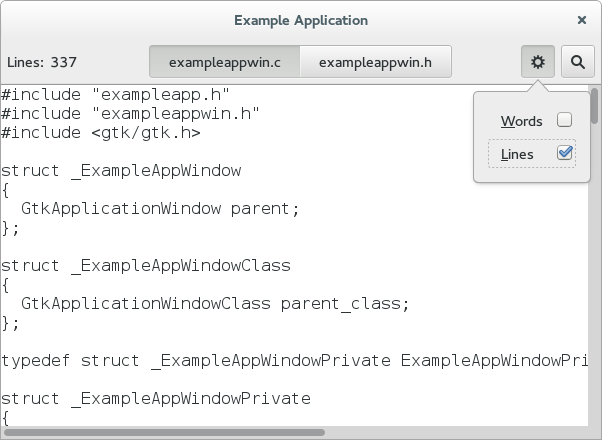属性
部件和其他的对象有许多有用的属性。
这里我们展示一些灵活的新方法来使用它们,可以通过GPropertyAction包装在action中,也可以用GBinding来绑定它们。
着手干吧,我们在窗口模板头栏增加两个lable,分别为lines_label和lines,然后在一个私有结构体中将它们和结构体成员绑定,就像我们前2次做的一样。
我们在工具菜单上增加一个新的Lines菜单项,它负责触发show-lines 动作。
<?xml version="1.0"?>
<interface>
<!-- interface-requires gtk+ 3.0 -->
<menu id="menu">
<section>
<item>
<attribute name="label" translatable="yes">_Words</attribute>
<attribute name="action">win.show-words</attribute>
</item>
<item>
<attribute name="label" translatable="yes">_Lines</attribute>
<attribute name="action">win.show-lines</attribute>
</item>
</section>
</menu>
</interface>
为了使这个菜单项起作用,我们为lines label的可见属性添加了一个属性动作,然后将它添加进了窗口动作。效果就是,每次lable一可见,该动作就被触发。
因为我们希望所有的label都能一起显示和消失,我们将lines-label部件的可见属性和lines部件相同属性绑定。
...
static void
example_app_window_init (ExampleAppWindow *win)
{
...
action = (GAction*) g_property_action_new ("show-lines", priv->lines, "visible");
g_action_map_add_action (G_ACTION_MAP (win), action);
g_object_unref (action);
g_object_bind_property (priv->lines, "visible",
priv->lines_label, "visible",
G_BINDING_DEFAULT);
}
...
我们需要一个计算当前活动标签行数的函数,然后更新lines label。如果你对细节感兴趣,请看全部源代码。
这使我们的范例程序如下所示:
